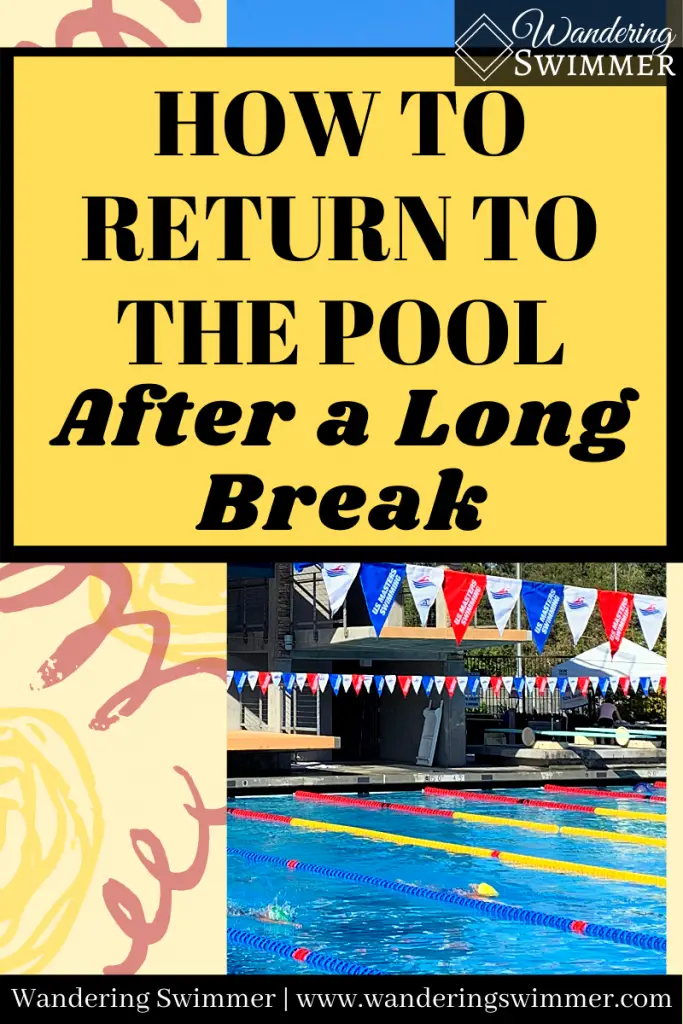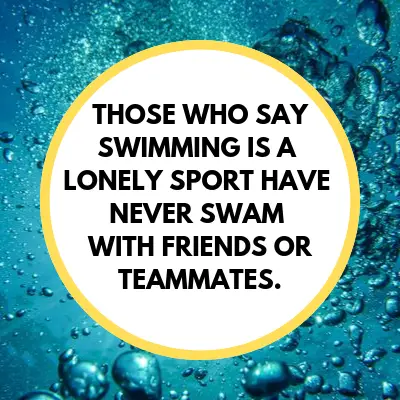Swimming isn’t just a physical sport. It’s also a mental sport. This means that when it comes time to return to the pool after a long break, you have to be mentally strong. Not just physically strong.
For swimmers coming back to the pool after COVID or any long break, such as an injury, mind over matter will play a large role.
Swimmers can either constantly live in the past and focus on what they used to have or where they used to be.
Or they can look towards the future. They can focus on where they need to go and how to get there while knowing that they’ll face obstacles.
More Content for You: Overcoming Failure in Swimming
It won’t be all sunshine and rainbows when you first get back into the water though.
Your stroke will feel awful and your endurance might be shot. But how you mentally prepare yourself will determine how smooth your transition back into the water will be.
Disclosure: This post may contain affiliate links, meaning I earn a small commission at no cost to you if you purchase something through one of my links. As an Amazon Associate, I earn from qualifying purchases. Please check out my disclosure page for more information.

Stay Positive
Easier said than done, right? A three-week break between seasons makes you feel out of shape. For some swimmers, it’s been at least three months. Phew, that’s a long time to be out of swimming shape.
But don’t let that get to you. Don’t solely focus on the time you spent out of the water and label it as a bad thing.
If you constantly focus on the negative things, your return to the pool will only feel that much worse. Instead, try to find something positive at each practice.
Related articles:
- Swimming After COVID-19 (And How it Might Look)
- 6 Tips to Survive Quarantine When Not Swimming
- Best Gear for Swimmers Returning to the Pool
Simply having a swim practice is something positive for most of us! Who cares if you feel weird or slow. It’s expected. Now push past that thought and look towards the positive.
During this time away from the pool, you probably had a chance to relax. And to catch up on a growing list of things you wanted to accomplish outside of swimming. Apply that same logic when you return to the pool after a long break.
Take the time to really focus on your stroke. Because let’s be honest. We all know we’re not going to be anywhere near our best times right at the start.
This gives swimmers a chance to work their strokes and double down on bad technique.
Starting new gives you a chance to end each practice on a positive note.
Look Forward, Not Back
Again, easier said than done. It’s incredibly tempting to come back to the pool and remember where you used to be. To recall what times and pace you could hold.
Time to get rid of that mentality. It won’t do anything for you but make you feel frustrated and discouraged.
It’s tempting, I know. And you will fall into the habit of saying ‘I used to be faster.’ Or, ‘I used to hold XYZ time in practice.’
And all of that is true! But it’s just not true the first day when you return to the pool after a long break. You have to build yourself back up.
Because while you might’ve kept up with your dryland workouts, that’s just dryland.
Related articles:
- How to Do Dryland Workouts at Home
- Best Dryland Equipment for Swimmers at Home
- Dryland Workouts without Weights at Home
We all know swimming exists on a different level. There’s being in shape and then there’s being in swimming shape. Dryland will only get you so far.
With that in mind, focus on each day and what you want to achieve at each practice. Keep looking forward and not back.
When you look forward, you can set goals for yourself and see yourself making progress.
Stay Patient
Yet another challenging one. Staying patient during the first few weeks or months after you return to the pool might seem difficult, but it will help.
This goes hand-in-hand with looking forward. If you don’t let yourself compare to where you were, you might find yourself being more patient. And might give you a better practice!
More Content for You: What is a Swim Team?
At the same time, while you might like to swim fast, now is not the time. If you’ve been out of the water for months, you will need to ease yourself back into your workouts.
Be patient with yourself and give yourself some slack. You won’t be able to hold the same times as you could before. Or swim as long as you could without stopping. It might not feel okay to you, but it is.
Keep working every day. Relish the victories, no matter how small or large. Don’t let yourself get caught up with intervals or times right now. All that will come back if you remain patient.
Be Ready for Some Emotions
Yes, you’re going to feel excited and happy to return to the pool after a long break. It’s exciting to see your teammates again and catch up with all that you’ve missed over the weeks or months.
But not everyone will share the same feeling.
Some, yourself included, might dread coming back because you know the challenge ahead of you.
What emotions might you feel?
- Frustration: At how slow your times are compared to where they were before the long break. At feeling out of shape in the water and how long it’ll take to build back the fitness/strength. And the frustration that other swimmers might be faster or came back better than them.
- Anxiety: From knowing how much training time you lost. It can sit like a weight on some swimmer’s shoulders. And it’s enough to make some question whether to start training again or hang up their suit for good
- Upset, sad, or discouraged: At how far back you feel in your training. Or how slow your progression is going as you begin training again.
Feeling frustrated or upset though is okay! It’s hard to come back to the pool after a long break and feel that you’re behind in the water. One thing to remember as you come back to train after COVID is that it’s okay to feel emotional.
The key though is to keep going. Keep training and pushing yourself. So long as you try to stay positive and keep moving forward. Remember to give yourself some grace!
You just have to keep pushing forward.
Facing Down Fear
Fear is a huge factor in a swimmer’s mentality. Both before and after COVID. We get anxious and nervous before a race. Or when we face something new such as a new team or a new event.
For swimmers training after a long break from the pool, fear by itself isn’t just a singular obstacle to overcome. Mentally, swimmers will face several different types of fear when returning to the pool.
More Content for You: How to Improve Your Swimming Performance
And these fears are completely valid. But there are also ways to help overcome these various mental blocks that come from fear.
Unknown Fear
A handful of swimmers know what it’s like to quit and then come back to the sport of swimming again. I imagine that for them, the transition back to the new normal will be somewhat familiar.
Personally, I retired for three years after college swimming before coming back to the sport. So I have an idea of what to expect. And I think I know the challenges that many others will face.
For the majority of swimmers though, a fear of the unknown will linger. The unknown of what to expect moving forward and what the future will look like. Whether or not they should consider quitting the sport.
Fear of the unknown keeps several of us from pursuing various different things. And a certain level of fear is healthy. So long as you don’t let it control your life.
We can’t go back to normal. Not yet. So yes, you’ll face unknowns in swimming and in life. The new normal is full of unknowns.
But the support of your team remains constant 🙂
Fear of Failure
Everyone faces fear of failure. As swimmers, we face this fear just before races and challenging sets. Of missing a cut, disqualifying, or letting someone down.
More Content for You: New Year’s Resolutions for Swimmers
I think one of the biggest fears that most swimmers will face is the fear of failure. In that, we’re scared that we won’t make it back to pre-COVID times. Or pre-COVID strength. That we’ll never be as good as we once were.
And while it’s a concern and isn’t unfounded, you’re not alone.
The majority of swimmers haven’t been training and also worry about this. One thing to consider though is that most swimmers will be starting at the same square one as you! Everyone will be coming back to the pool after months of not training.
They’ll face the same challenges, fears, and frustrations as you.
I don’t know about you, but that makes me feel a bit better. Knowing that I won’t be alone in this!
COVID Fears
The fear of catching COVID is 100% real for most people. It’s one of the reasons some of us aren’t back training yet. Or haven’t been out socializing or not leaving the house without a mask.
There’s no getting over this mental fear when it’s a very real fear/threat.
You can argue that everything is just in your mind. And it’s only your mind casting doubt. But the chance to catch COVID isn’t the mind playing games with us. It’s a fact and it can happen.
Swim teams and swim programs, such as USA Swimming have already started designing ways for swimmers to return to the pool safely. From limiting the number of swimmers in the lane to closing locker rooms, these suggestions are there for your safety.
Related articles:
Are they 100% safe? No. These suggestions are there to help limit exposure and contact. The rest relies on you taking proper and safe measures. As well as your teammates to follow guidelines.
It’ll be a challenge and will take time to adjust to. I have no doubt about that. But if everyone acts with the best interest of each other and follows the set guidelines by the CDC, then it’s possible to train again.
However, please do what you feel is best. If you’re high-risk or you don’t feel comfortable training with others then don’t. Your health, safety, and well-being always come first.
Support and Encouragement
With everything seemingly stacked up against swimmers as they return to the pool after COVID or an equally long break, it might seem overwhelming. The various emotions and the new normal.
So what’s a swimmer to do?
Find support with your teammates. Lean on them (figuratively, of course. Remember to keep social distance!) when you’re feeling down or unmotivated. Your teammates have the chance to be your biggest supporter.

And during these weeks or months of returning to the pool, we’re all going to need a healthy dose of support and encouragement.
Putting down others won’t do anyone any favors. Now more than ever, we need to rally around our teammates. Especially those struggling. Swimming might be an individual sport but we’re all in this together at the end.
Stay positive and supportive. If not for yourself, then for another teammate. Be encouraging whenever you can.
A little bit of kindness goes a long way.
In Closing
These next few weeks or months will offer a new challenge to swimmers that most haven’t faced yet. But take it from someone who retired for a few years before coming back (that’d be me 😉 ), you can do it.
Yes, it’ll take time and effort on your end, but you already know how to do that. You’ve done it countless times in the past and you’ll rise to the challenge again. Don’t let yourself despair when the going gets rough.
Instead, keep going.
Take it one practice at a time. Keep to your nutrition plan, your dryland, and above all, don’t give up.
You’ve got this rock star!
As always, to happy swimming!
-Chevron
Bonus Content:
A Swimmer’s Review of the YYST Swim Bungee: Swimming at home in your backyard pool is possible by using a swim bungee. For swimmers of any level, the YYST Swim Bungee is affordable and easy to use.
Surviving Quarantine When Not Swimming: Find yourself struggling because you can’t swim? try these 6 suggestions to help you survive quarantine when not swimming.

Want to Improve at the Pool?
Join swimmers and swim parents to receive my free newsletter and receive a free Swimming Glossary e-book as a thanks!
Every month you’ll receive tips and coaching to help you find success at the pool.
Hello! I’ve been following your site for a while now and finally got the bravery to go ahead and give you a shout out from Houston Tx!
Just wanted to say keep up the great work!